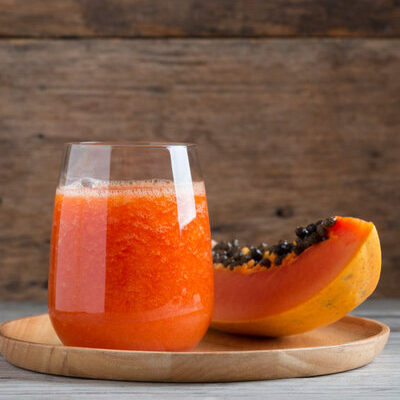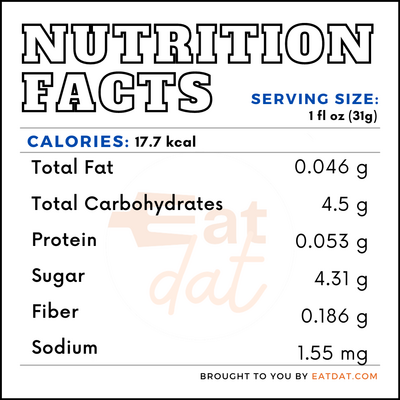
Papaya Juice
What is Papaya Juice?
Papaya juice is juice made by blending the soft and smooth papaya fruit with water. Sometimes, the juice is also strained to remove the pulp and other particles. The fruit, classified as a berry, grows in tropical climates and is also known as pawpaw.
- Papaya has an inedible yellow skin and a fleshy orangish yellow interior with a central cavity that contains a large number of black seeds.
- This fruit has a sweet taste and a soft and juicy flesh, well suited for making fruit juice, smoothies, milkshakes, and other sweet treats.
Some fruits that accompany papaya juice well include:
- Watermelon
- Banana
- Orange
- Pineapple
- Coconut
- Apricot
- Lemon
Origin of papaya
This fruit may have originated in Mexico or other countries in Central America. Later, it spread to neighboring countries throughout South and Central America, as well as the West Indies, the Bahamas, and Bermuda. In the 1500s, Spanish colonizers carried the seeds to the Philippines, which led to its distribution throughout the warm climates of Asia. A century later, papaya traveled from India to Italy. Today, the fruit grows around the world in all tropical climates and this juice is a popular beverage.
Nutrition
A single glass has 141 calories. The nutritional profile for papaya juice is:

In addition, this fruit juice contains essential micronutrients such as calcium, potassium, magnesium, sodium, vitamins A & C, carotene, cryptoxanthin, and lutein. Regular consumption may lower the risk of cardiovascular diseases and colon cancer due to the known antioxidants in it. Also, it helps in reducing the symptoms of arthritis, digestive problems, ringworm, hypertension, and malaria.
Commercial production
Papaya requires a warm climate and plenty of rainfall. Soils with good drainage and light which are rich in organic matter ensure a good growth of this fruit. Papaya juice is prepared by blending fresh papaya with water, sugar, salt, and lemon juice. Then, it is homogenized and pasteurized before packaging.
India is the top producer of papaya in the world with a share of 38.61 percent of the global market. Other main producers are Brazil, Mexico, Indonesia, Dominican Republic, Nigeria, Democratic Republic of the Congo, Cuba, Colombia, Thailand, and Peru. Nonetheless, Mexico is the leading exporter of papaya. Other top countries include Brazil, Belize, Malaysia, and India.
Papaya juice recipes
This fruit juice is delicious, refreshing, and blends well with many ingredients. Here are a few recipes:
- Papaya Juice
- Papaya Pineapple Juice
- Papaya Halwa
- Papaya Bars
- Papaya Smoothie
- Papaya Lassi
- Papaya Paste
- Papaya Marinated Steak
FDA regulations
The Food & Drug Administration classifies papaya as a raw agricultural commodity. Therefore, it regulates the growing, harvesting, packing, and holding of this fruit. Papaya juice must have at least a 11.5 percent concentration, according to FDA regulations.
References
Morton, J. 1987. Papaya. p. 336–346. In: Fruits of warm climates. Julia F. Morton, Miami, FL., https://www.hort.purdue.edu/newcrop/morton/papaya_ars.html
Edward A. Evans and Fredy H. Ballen, An Overview of Global Papaya Production, Trade, and Consumption, IFAS Extension, University of Florida, https://edis.ifas.ufl.edu/publication/FE913
Mohamed Sadek, Kadry. “Antioxidant and immunostimulant effect of carica papaya linn. Aqueous extract in acrylamide intoxicated rats.” Acta informatica medica : AIM : journal of the Society for Medical Informatics of Bosnia & Herzegovina : casopis Drustva za medicinsku informatiku BiH vol. 20,3 (2012): 180-5. doi:10.5455/aim.2012.20.180-185, https://www.ncbi.nlm.nih.gov/pmc/articles/PMC3508853/
